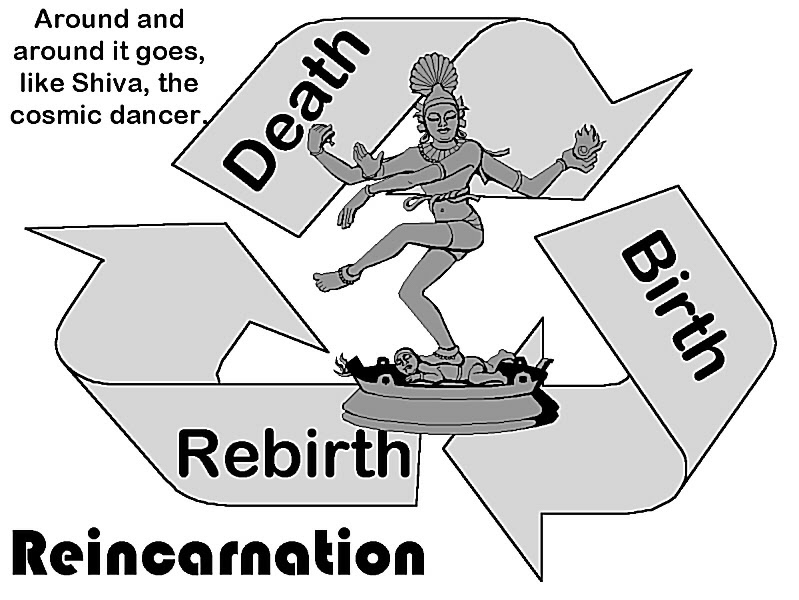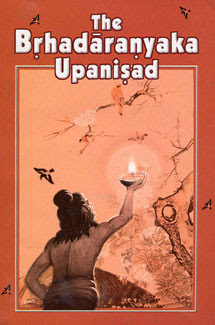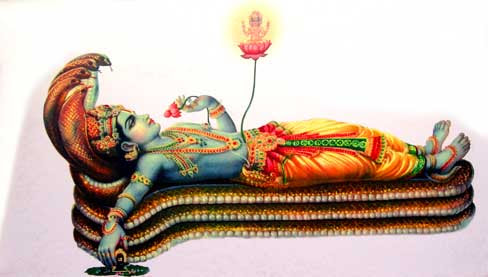THE DOCTRINE OF REINCARNATION: What Hindu Scriptures reveal?
“Birth and death are doors through which you pass from one dream to another. Someone is born on Earth in France as a powerful king, rules for a time, then dies. He may be reborn in India, and travel in a bullock cart into the forest to meditate. He may next find rebirth in America as a successful businessman; and when he dreams death again, reincarnates perhaps in Tibet as a devotee of Buddha and spend his entire life in a lamasery… What is the difference? Each existence is a dream within a dream, is it not?” Pramahamsa Yogananada
"It is the secret of the world that all things subsist and do not die, but only retire a little from sight and afterwards return again. Nothing is dead; men feign themselves dead, and endure mock funerals… and there they stand looking out of the window, sound and well, in some strange new disguise." —Ralph Waldo Emerson
 The doctrine of transmigration / reincarnation as a dominant ideology has exercised significant influence on almost every aspect of Indian thought. In fact the belief in reincarnation is usually associated with the philosophies and religions of India such as Hindus, Buddhists, Sikhs and Jains. Although the belief in reincarnation is pervasive in the religious tradition of eastern traditions, it is also found throughout the world. It is also remarkable to find that the belief in birth, death, rebirth and other world is prevalent among majority of the countries. Although majority of the Christians have considered the belief in life after death an anathema for many centuries, the twentieth century is witnessing a remarkable change in attracting all great-religions to the idea of reincarnation.
The doctrine of transmigration / reincarnation as a dominant ideology has exercised significant influence on almost every aspect of Indian thought. In fact the belief in reincarnation is usually associated with the philosophies and religions of India such as Hindus, Buddhists, Sikhs and Jains. Although the belief in reincarnation is pervasive in the religious tradition of eastern traditions, it is also found throughout the world. It is also remarkable to find that the belief in birth, death, rebirth and other world is prevalent among majority of the countries. Although majority of the Christians have considered the belief in life after death an anathema for many centuries, the twentieth century is witnessing a remarkable change in attracting all great-religions to the idea of reincarnation.

Swami Vivekananda also talks about “the doctrine of the Atman and the reincarnation of the soul; it maintains that innumerable individual souls, having taken body after body again and again, go round and round in the wheel of birth and death according to their respective Karmas; this is Samsâravâda, or as it is commonly called the doctrine of rebirth.” There are four basic principles involved in the explanation of Hindu doctrine of reincarnation.
First, the belief in the permanence of the essential self (Soul, atma). Without this belief of Soul's permanent nature, the discussion of reincarnation is meaningless. Second, the belief in avidya (ignorance) which causes the self assume an individuality of its own resulting in multiple births. Third, the belief in the concept of liberation (Moksha), Moksha implies that one has the potential to realize one's own true self. It is considered the birthright of every Hindu to be liberated from human bondage and be united with the Brahman (God, the Supreme Spirit) provided one is released from the ignorance. Fourth, the law of Karma affects the theory of rebirth. According to this law, every action of the individual leads to an inevitable result, good or bad. The actions in the present life conditions future nature of birth the same way as the actions in the previous life impacted the present life.
Belief in the theory of reincarnation is widespread in many religion of the work at one time or the other. However, contribution of Hinduism to the doctrine of transformation is distinction and more significant. Since the Vedic times, the concept of rebirth has been well established and is abound in the Hindu literature --Upanishads, Puranas, Gita, Itihasas and other books written by prominent sages and scholars. The basic tenets of the belief is transmigration are summarized by Bloomfield as follows:
"Every living creature is reborn in some organic shape: every living creation had a previous existence; and every living creature is again and again in the prey of death, until in some life all desire and all activity as the outcome of desire shall have been laid aside.” (1908: 258). W. R. Alger describes the importance of the doctrine of metempsychosis in his monumental work, A Critical History of the Doctrine of a Future Life. "No other doctrine has exerted so extensive, controlling, and permanent an influence upon mankind as that of the metempsychosis, ‑‑ the notion that when the soul leaves the body it is born anew in another body, its rank, character, circumstances and experience in each successive existence depending on its qualities, deeds, and attainments in its preceding lives." 
Vedic Period
It is believed that the Vedic period was not known to expound the doctrine of the Soul's migration.
Richard Garbe observed that "in the ancient Vedic period it had as yet no existence. At the time the Indian people...believed that good men ascended to the heaven to the companionship of the gods... [while] the Souls of the wicked sank down into the abyss of hell." (1921: 436), Albert Schweitzer also stated that "the hymns of the Rig-Veda knew nothing as yet of a cycle of birth." (1957:47).
However, S. Radhakrishnan observes that the elements of the doctrine of reincarnation are traced back to the Vedas. "The passage of the Soul from the body, its dwelling in other forms of existence, its return to human form, the determination of future existence by the principle of Karma are all mentioned.: In fact Upanishads themselves ascribe the elements of soul's migration of the Rigveda. Vamadeva, believed to be the poet of Rigveda IV, recognized himself as Brahman and as a proof he indicated his acquaintance with his former lives as moon and sun. "The Rishi Vamadeva saw and understood it, singing, 'I was Manu (moon), I was the Sun'" (26.1) He further goes on to sing that "while still in the womb, I knew all the generations of these gods. A hundred iron fortresses guard me, but still, like an eagle, swiftly flew away." (Rigveda VI. 27.1) This quotation would be meaningful only if we refer to the eagle as the soul and the iron fortresses as the bodies through which the soul wanders. However, Paul Deussen(1966: 319) states that "The hymns of the Rigveda therefore know nothing yet of a migration of the soul, but teach for the good a continued existence with the gods."
Although Vedas did not address the issue of the mechanics of soul's migration, they illustrated a number of instances dealing with the concepts of death and rebirth.

“He, born afresh, is new and new forever." Rigveda X: 85:19)
"The ancient goddess [Dawn], born again and again, dressed in the same color." (Rigveda I: 92.10)
"I seek neither release nor return." (Rigveda V. 46.1)
"The immortal self will be reborn in a new body due to its meritorious deeds." (Rigveda I.
164.48)
"With your gentle forms, O known of creatures, carry this man to the world of those who have done good deeds... let his reach his own descendants, dressing himself in a life-span. O known of creatures, let him join with a body." (I. 16. 4-5)
These statements illustrate that the Vedic man refused to succumb to death as the final of irreversible phase of life and made numerous efforts to bring the decreased back to life again. One of the hymns describes all the possible places where the spirit of the dead man may have gone and urging to come back again to earth. The places the spirit of the dead man may have gone include: Yama, heaven and hell, four corners of the earth, four directions of space, waves of ocean, shining light rays, the waters and the planets, the sun an dawn, highest mountains, the whole world, the farthest realms, and the past and the future. Since return to earth was considered the greatest blessing, referring to the spirit, hymn states: "may it return to you again, that it may live and dwell here" from all the above mentioned places (Rigveda X 58. 1-12). In a similar manner, another hymn appeals impassionately for the dead man's return, for his prolongation of human life and for rejuvenation of live. “Now may his life be renewed and further extended ...let us do many noble deeds to win glory.... May we surpass our foes by deeds of Valor, as heaven surpasses earth and mountains surpass the plains..." (Rigveda, X: 59)
Although the doctrine of reincarnation in Vedas is not as explicit as in Upanishads, which we shall examine next, we cannot deny its prevalence during the early Aryan and Vedic period. Max Muller argues that if the references seem rare it is because that "we have no right to suppose that we have even a hundredth part of the religions and popular poetry that existed during the Vedic age." (1899: 41)
Upanishads
The doctrine of reincarnation deals with the rebirth of the atma (soul) in a series of physical bodies which are basically either human or animal in nature. There are also instances where the soul takes birth in divine, demonic, and vegetative embodiments. This doctrine of reincarnation is more elaborately developed in Upanishads over a period of time. They believed in the continuity of life after death of the physical body and also indicate some definite ideas about the destinies of the soul after it departs the body.
The soul passes through different paths, experience the consequences of their activities and are reborn as different persons depending on the code of conduct. "According, those who are of pleasant conduct here-- the prospect is indeed, that they will enter a pleasant womb, either the womb of a Brahman, of the womb of a Kshatriya, or the womb of a Vaisya. But those who are of stinking conduct here - the prospect is, indeed, that they will enter a stinking womb, either the worn of a dog, or the womb of a swine, or the womb of an outcast." (Chandogya Upanishad 5.10.7). Similar discussion was also found where the deeds based on the knowledge determined the nature of birth. "One goes into the womb of a mother becoming incarnated in bodily form; another enters into a plant. Each according to his deeds, according to his knowledge." (Katha Upanishad 5.7). The character, that determines one's position in the future life, is formed not only by action but also by knowledge." Either as a worm, or as a moth, or as a fish, or as a bird, or as a snake, or as a tiger, or as a person, or as some others' in this or that condition, he is born again here according to this deeds, according to his knowledge." Kaushika Upanishad 1.2).

Brihadaranyaka Upanishad deals with the subject of death and rebirth. The knowledge gained by performing various deeds in this life along with past experience follow the self after leaving its present body and enters another physical body:
"An just as a leach moving on a blade of grass reaches its end, takes hold of another, and draws itself together towards it so does the self, after throwing off his body, is to say, after making it unconscious, take hold of another support and draw itself together towards it."
"And just as a goldsmith takes a small quantity of gold and fashions [that of it] another -- a newer and better -- form so does the self, after throwing off his body, that is to say, after making it unconscious, fashion another -- a newer and better -- form suited to the Manes or the gandharvas, or the gods, or viraj, or Hiranyagarbha, or other beings." (IV: IV: 3-4)
Based on these statement, it is evident that the new body will engage in somewhat similar activities depending on the previous life’s experiences. The individual self is believed to enter a new body made of five gross elements - ether, fire, wind, water, and earth. What kind of body the soul enters and what kind of individuality it develop depend on desires, words and actions.
"As a man acts, so does he become. A man of good deeds becomes good, a man of evil deeds become evil. A man become pure through pure deeds, impure through impure deeds."
As a man's desire is, so is his destiny. For as his desire is, so is his will; and his will, so is his deed; and as his deed is, so is his reward, whether good or bad.
A man acts in the new life depending on his previous life’s experiences, desires and sadhanas. After death he goes to the next world, enjoys the fruits of his deeds, and then returns to the next life to fulfill the unfulfilled desires. No desires, no rebirth. More desires, more births.
"But he in whom desire is stilled suffers no rebirth. After death, having attained to the highest, desiring only the self, he goes to no other world. Realizing Brahman, be becomes Brahman.
"When all the desires which once entered into his heart have been driven out by desire knowledge, the mortal, attaining to Brahman become immortal.
As the slough of a snake lies cast off on an anthill, so lies the body of a man at death; while he, freed from the body, becomes one with the immortal spirit, Brahman, the light eternal" (Brihadaranyaka Upanishad: IV: 5-7).
Karma theory is a very powerful doctrine that holds an important place in the Hindu religion. According to this theory, one's actions, bad or good, in this life one passes into the body of a higher or lower embodiment after the soul departs the body. The numbersamsaras one goes through depends on the kind and qualities of actions.
“According unto his deeds the embodied one successively assumes forms in various conditions.
Coarse and fine, many in number, The embodied one chooses forms according to his own qualities.
[Each] subsequent cause of his union with them is seen to be because of the quality of his acts and of himself." (Svetasvatara Upanishad 5.11-12)
Upanishads provide their own explanation of rebirth. Since Karma (actions) is believed to be an accurate determinant of the state of the mind, it determines the rebirth. They explain the process through which one attains rebirth. A person consists of desire. As is his desire, so is his will; as is his will, so is the deed he does, whatever deed he does, that he attains." (Brihadaranyaka Upanishad 4.4.5)

“As the embodied soul continually passes, in this body, from boyhood to youth to old age, the soul similarly passes into another body at death. The self-realized soul is not bewildered by such a change.“ Bhagavad-gita 2.13
“For the soul there is never birth nor death. Nor, having once been, does he ever cease to be. He is unborn, eternal, ever-existing, undying and primeval. He is not slain when the body is slain.” Bhagavad-gita 2.20
“As a person puts on new garments, giving up old ones, similarly, the soul accepts new material bodies, giving up the old and useless ones.” Bhagavad-gita 2.22
“It is said that the soul is invisible, inconceivable, immutable, and unchangeable. Knowing this, you should not grieve for the body.”Bhagavad-gita 2.25
After explaining the concept of samsara – the endless cycle of birth, death and rebirth – Lord Krishna explains that nobody can escape from being engaged in some kind of activity which traps one to repeated births. But there is a way to escape the samsara to attain moksha. Lord Krishna says, "Not by abstaining from work can one achieve freedom from karma, nor by renunciation alone can one attain perfection" (3:4). It is through nishkama karma - detachment from its fruits - one is freed from the bondage, free from the repeated births. According to Krishna: “Be focused on action and not on the fruits of action. Do not become confused in attachment to the fruit of your actions and do not become confused in the desire for inaction.” (2:47). As a result, Krishna advises Arjuna thus: "Always act with detachment to the fruits of actions. The one who is acting without attachment attains God" (3:19)

Karma theory explains the reasons for the repeated births and deaths. It is karma that explains the apparent disparity among people, inequality, injustice and partiality. When we look around we see that some people are born poor while others rich; some ignorant, others intelligent; some paupers, others philosophers; some born with deformities, others with good physical forms; some with health problems, others with excellent health; some starve, others over eat; some uneducated, others highly educated; some suffer continuously, others enjoy life; some born in royal families, other in poor families; some with tranquility, others with bad temper; some born in one country, others in other countries; some die within few minutes after birth, others live be more than hundred years; Some always successful, others always a failure; some honest, some dishonest; some commit crimes, some practice nonviolence; some are vegetarian, some non-vegetarian; some are women, others are men; some tall, others short; some with excellent talents and skills, others with no skills, etc. The list goes on.
These disparities are mainly the result of their actions in previous lives and the present conditions. Men's present dispositions are the results of their past, and their present actions create their future. What is called fate or destiny is nothing but the accumulation of tendencies created by past actions and thoughts. The present station of the individual can be altered by new actions and thought process. A man can shape his own future either for this life or for future lives. If we accept that the present condition is the result of the past deeds, a thoughtful man should engage in actions that are conducive to improve his current status and also willingness to avoid the sinful acts. Veil of ignorance must be lifted to allow more knowledge to flow to reach moksha and avoid the samsara trap.
Every action has a consequence. A good deed always brings its good fruits while bad ones bad fruits. You will find in Mahabharata: “Just as a calf finds out its mother among a thousand cows, so also an action that was performed in a previous birth follows the doer.”
Yadrisam kriyate karma tadrisam bhujyate phalam,
Yadrisam vapyate, bijam tadrisam prapyate phalam.
The Karma theory teaches us that we reap what we sow. The fruit of the tree corresponds to the seed that has been sown. Similarly, rewards or punishments always correspond to the kind of activities. That is the nature of law. A person who engages in evil actions cannot expect happiness, peace and prosperity either in this or in his next life.

Yoga Vasishta also describes the past and future lives. “Many are the times we have been together in the past, and also been separated and so again shall it be in the future. Even as a heap of grain removed from granary to granary ever assumes new order of arrangement and new combination, so is the case with Jiva (human being) in the universe through his arrangement.”
In a similar vein, Thirumantiram stated that at the time of death, the soul is simply released from the current body and moves on to another. "Even as the snake sloughs off its skin, even as the bird leaves its shell, even as in its waking state the soul forgets happenings of the dream state, thus does the soul migrate from one body to another..." (Tirumantiram 2132)

Adi Shankara, the great Advaita philosopher, believed that the whole world is maya (illusion). It is like dream. Ignorance (avidya) of the real nature of life has trapped one into this cycle of birth, death and rebirth. After repeated births, one would realize that the real happiness (ananda) does not come from this physical body but only through higher forms of spiritual experience. Thus, Adi Shankara begs Lord Krishna to redeem us from samsara in his composition entitled “Bhaja Govindam:”
pun arapi jananam punarapi maranam
punarapi jananii jathare shayanam
iha samsaare bahudustaare
kripayaa apaare paahi muraare
("Born again, death again, birth again to stay in the mother's womb! It is indeed hard to cross this boundless ocean of samsara. Oh Murari! Redeem me through Thy mercy.").
The question is how do we redeem ourselves from the cycle of birth, death and rebirth? According to Adi Shankra only the knowledge of the saintly seer can bring that moksh (salvation) which recognizes the close relationship between self and the universe, Atman and Brahman, soul and God, and the merging or absorption of the part in the whole. Only when this absorption is complete, the cycle of birth and rebirth stops. Once they merge into Brahman, they will enjoy the eternal bills: "This is a place of intensely spiritual atmosphere, whose inhabitants live, free from disease, old age, and death, enjoying uninterrupted bliss in the companionship of the Deity." Till then, everything is maya (illusion).
- Part of this speech was presented at the Hindu Temple of Amarillo, Texas.
As many of you know that SaveTemple Office was opened in June 2012 in Hyderabad. Office is located in Khairatabad. Four full time employees are working on the update of our website, Aalayavani Web Radio, Aalayavani magazine, conducting various activities to preserve and protect Hindu Temples and Culture. Our budget is approximately 2 lakh rupees per month. We request your generous donation to conduct activities to promote unity among Hindus and restore the glory of Hinduism.
Please DONATE. Your donations are appreciated to continue the work.
NOTE: GHHF is exempt from federal income tax under section 501 (c) 3 of the Internal Revenue code. Our tax ID # 41-2258630
Please send your tax-deductible donations to:
Global Hindu Heritage Foundation,
Please subscribe to Save Temples Telegram channel at https://t.me/savetemples
GHHF Board of Directors:
Prakasarao Velagapudi PhD, ( cell), ( home); (; ); Satya Dosapati (); (); (); Vinay Boppana (248-842-6964); (); (); (); (); (); (); (); (); Murali Alloju MD (703-953-1122); Veeraiah Choudary Perni MD (330-646-8004); Vishnu Kalidindi MD; Srivas Chebrolu MD; Avadesh Agarwal; Sudheer Gurram MD; Rajendrarao Gavini MD; Srinath Vattam MD; and Dr. Ghazal Srinivas, Honorary Brand Ambassador.
GHHF Dallas Core Group
(); ); Srinivas Pamidimukkala (); (); (); (); (); (}; (); (); (); (); (); (); (); (); (); (); Sitaram Panchagnula (714-322-3430); Vasanth Suri (408-239-3436); Phani Aduri (214-774-2139); Konda Srikanth (214-500-5890); Siva Agnoor (214-542-661).











 Urgent support needed for Bangladesh Hindus
Urgent support needed for Bangladesh Hindus 







